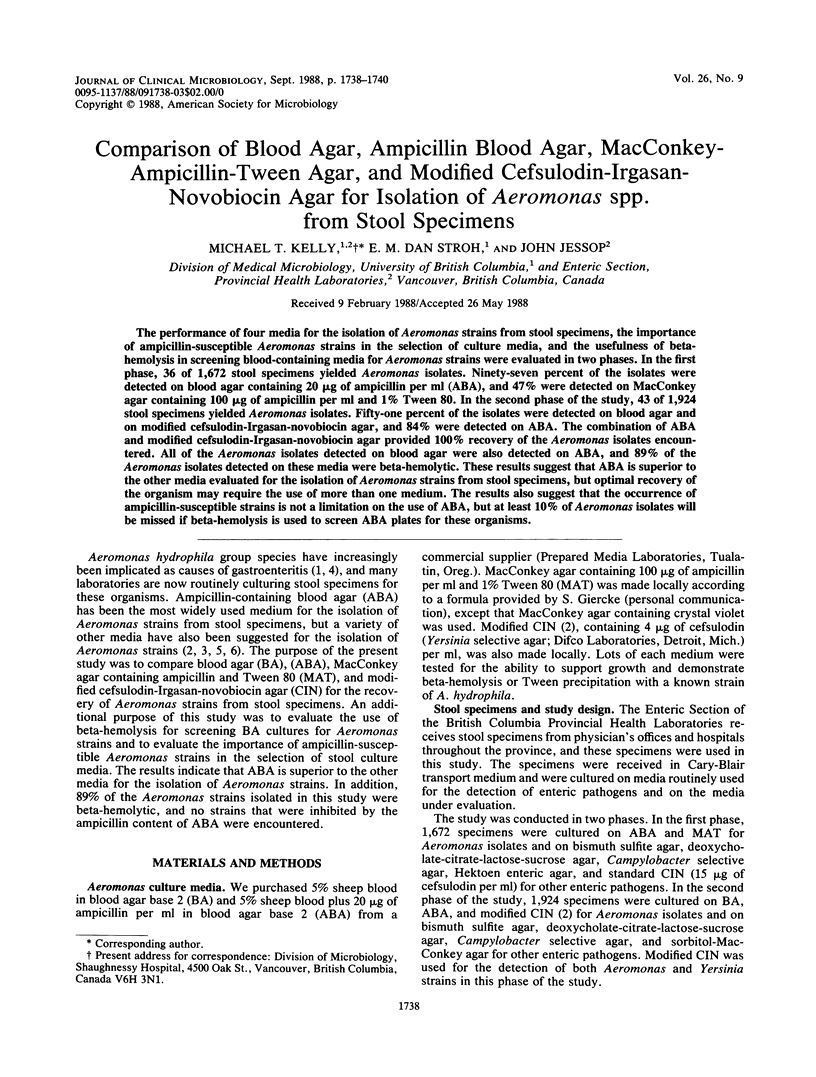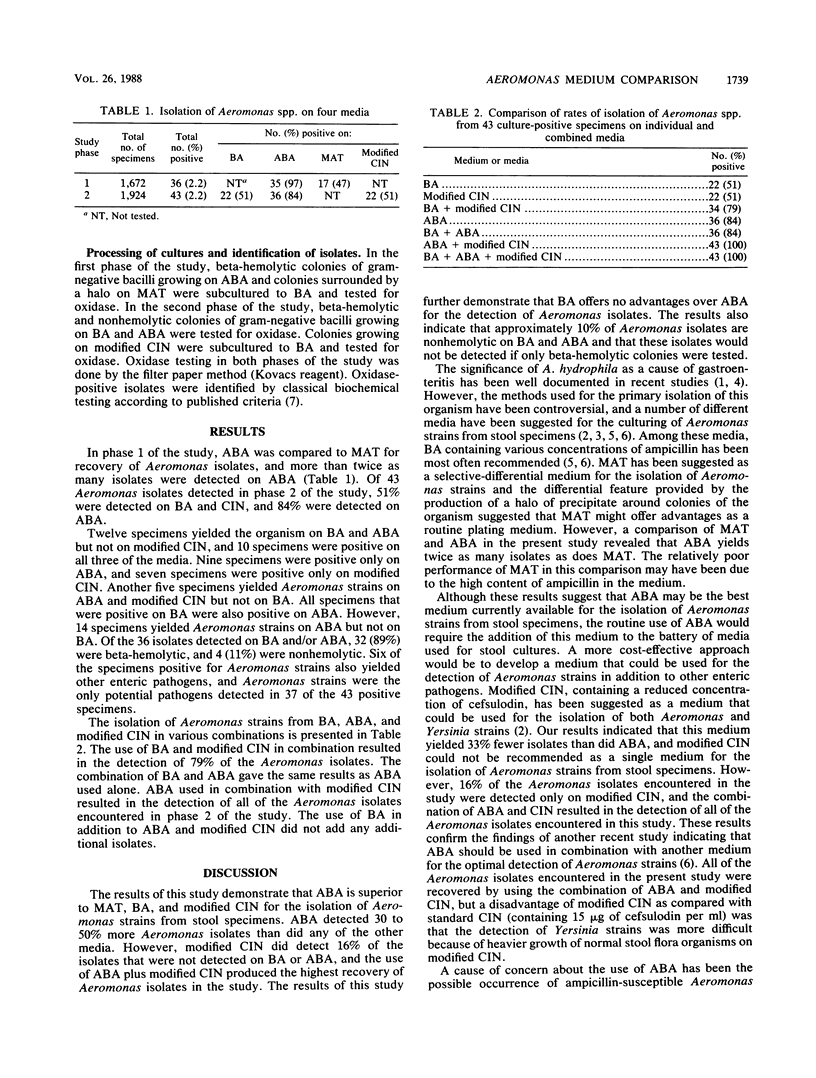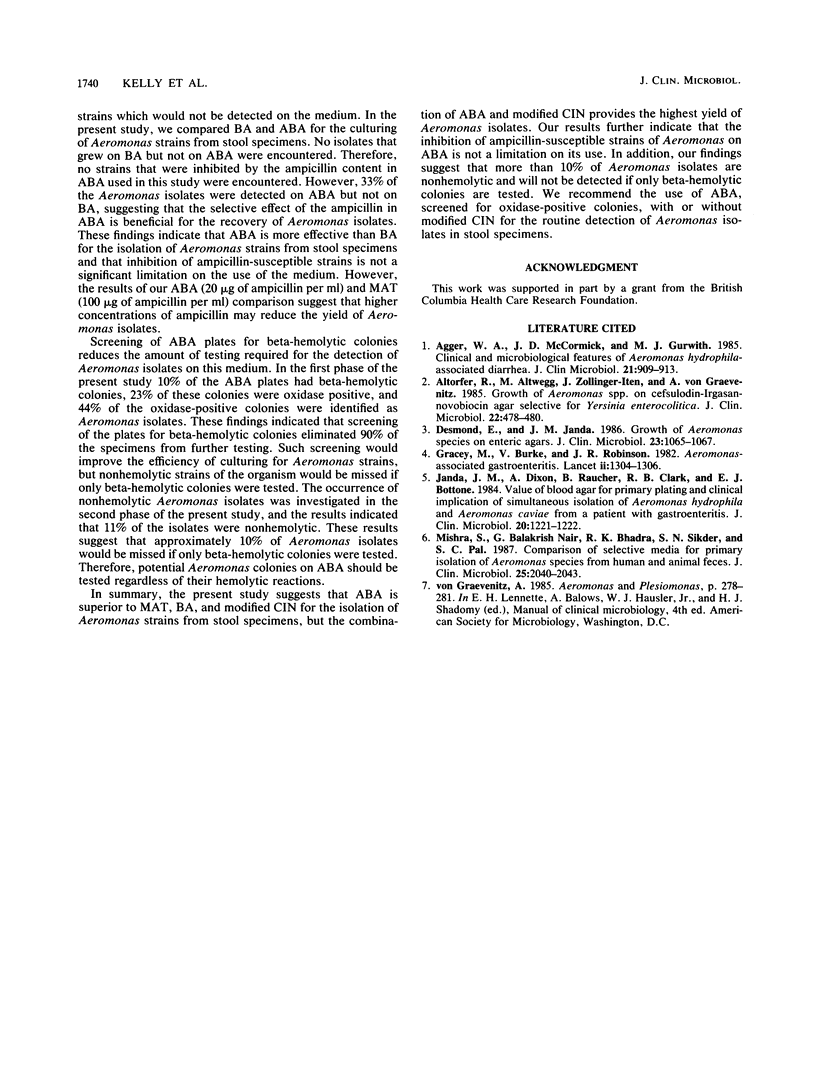Abstract
The performance of four media for the isolation of Aeromonas strains from stool specimens, the importance of ampicillin-susceptible Aeromonas strains in the selection of culture media, and the usefulness of beta-hemolysis in screening blood-containing media for Aeromonas strains were evaluated in two phases. In the first phase, 36 of 1,672 stool specimens yielded Aeromonas isolates. Ninety-seven percent of the isolates were detected on blood agar containing 20 micrograms of ampicillin per ml (ABA), and 47% were detected on MacConkey agar containing 100 micrograms of ampicillin per ml and 1% Tween 80. In the second phase of the study, 43 of 1,924 stool specimens yielded Aeromonas isolates. Fifty-one percent of the isolates were detected on blood agar and on modified cefsulodin-Irgasan-novobiocin agar, and 84% were detected on ABA. The combination of ABA and modified cefsulodin-Irgasan-novobiocin agar provided 100% recovery of the Aeromonas isolates encountered. All of the Aeromonas isolates detected on blood agar were also detected on ABA, and 89% of the Aeromonas isolates detected on these media were beta-hemolytic. These results suggest that ABA is superior to the other media evaluated for the isolation of Aeromonas strains from stool specimens, but optimal recovery of the organism may require the use of more than one medium. The results also suggest that the occurrence of ampicillin-susceptible strains is not a limitation on the use of ABA, but at least 10% of Aeromonas isolates will be missed if beta-hemolysis is used to screen ABA plates for these organisms.
Full text
PDF


Selected References
These references are in PubMed. This may not be the complete list of references from this article.
- Agger W. A., McCormick J. D., Gurwith M. J. Clinical and microbiological features of Aeromonas hydrophila-associated diarrhea. J Clin Microbiol. 1985 Jun;21(6):909–913. doi: 10.1128/jcm.21.6.909-913.1985. [DOI] [PMC free article] [PubMed] [Google Scholar]
- Altorfer R., Altwegg M., Zollinger-Iten J., von Graevenitz A. Growth of Aeromonas spp. on cefsulodin-Irgasan-novobiocin agar selective for Yersinia enterocolitica. J Clin Microbiol. 1985 Oct;22(4):478–480. doi: 10.1128/jcm.22.4.478-480.1985. [DOI] [PMC free article] [PubMed] [Google Scholar]
- Desmond E., Janda J. M. Growth of Aeromonas species on enteric agars. J Clin Microbiol. 1986 Jun;23(6):1065–1067. doi: 10.1128/jcm.23.6.1065-1067.1986. [DOI] [PMC free article] [PubMed] [Google Scholar]
- Gracey M., Burke V., Robinson J. Aeromonas-associated gastroenteritis. Lancet. 1982 Dec 11;2(8311):1304–1306. doi: 10.1016/s0140-6736(82)91510-0. [DOI] [PubMed] [Google Scholar]
- Janda J. M., Dixon A., Raucher B., Clark R. B., Bottone E. J. Value of blood agar for primary plating and clinical implication of simultaneous isolation of Aeromonas hydrophila and Aeromonas caviae from a patient with gastroenteritis. J Clin Microbiol. 1984 Dec;20(6):1221–1222. doi: 10.1128/jcm.20.6.1221-1222.1984. [DOI] [PMC free article] [PubMed] [Google Scholar]
- Mishra S., Nair G. B., Bhadra R. K., Sikder S. N., Pal S. C. Comparison of selective media for primary isolation of Aeromonas species from human and animal feces. J Clin Microbiol. 1987 Nov;25(11):2040–2043. doi: 10.1128/jcm.25.11.2040-2043.1987. [DOI] [PMC free article] [PubMed] [Google Scholar]


